

Ultimate Guide to Purchase Requisitions Approval Process
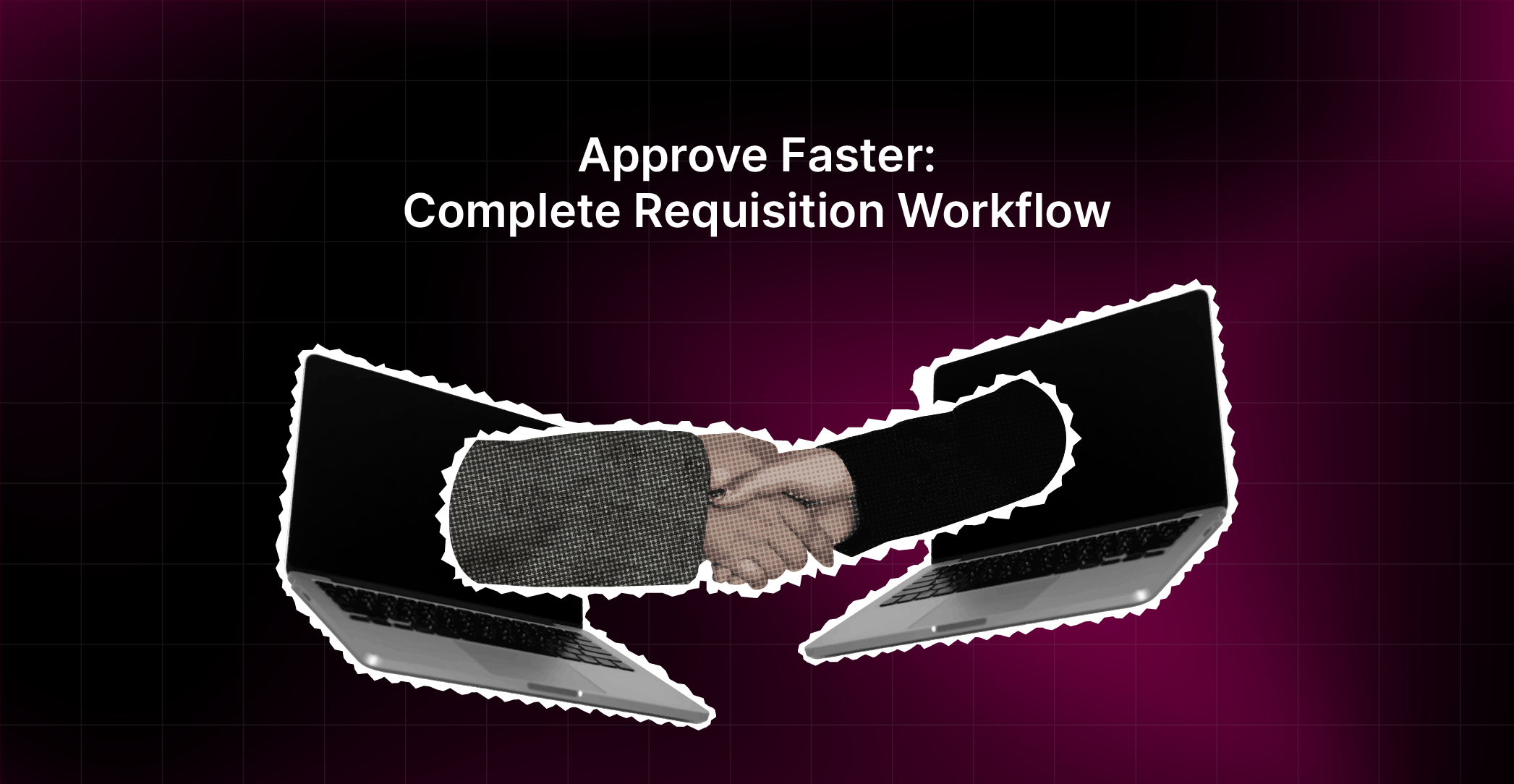
Ultimate Guide to Purchase Requisitions Approval Process
This guide breaks down the purchase requisition approval process, covering key steps, approval types, and best practices for optimizing efficiency and spend con


Purchase requisitions are an essential part of the procurement process. They ensure that all purchases are properly validated, budgeted for, and approved before a purchase order is issued to a vendor.
With a well-defined purchase requisition approval process, you’ll have better control over company spending. For example, you can route purchase requests to the appropriate managers and stakeholders for approval based on factors like the dollar amount, department, or type of goods/services being requested.
We've put together this comprehensive guide to help you understand the importance of requisitions approval process, their challenges, and best practices.
What Is The Purchase Requisition Approval Process?
The purchase requisition approval process is the series of steps a purchase request goes through to verify that it identifies a need for goods or services. They fill out a purchase requisition form, either on paper or digitally in a procurement system.
This form captures key details such as:
- Description of the items or services needed
- Quantity
- Estimated price
- Business justification
- Delivery requirements
- Suggested vendor (if applicable)
The employee submits the completed requisition, kicking off the approval workflow. Based on predefined business rules, the requisition routes to the necessary approvers in the proper order.
For example, the requisition might first go to the employee’s direct manager. The manager reviews the request to confirm the need and ensure it aligns with team goals and budget. If approved, the requisition then routes to the next approver, such as a department head or VP.
Depending on the nature and value of the purchase, additional approvals may be needed, such as:
- Legal review to check contract terms or regulatory compliance
- IT approval for technology purchases
- Finance review for budget availability and proper accounting
- Executive sign-off for high-value purchases
At each stage, the approver can accept, reject, or request changes to the requisition. If rejected, the requester is notified and can make changes and resubmit if needed.
Once the requisition has received all necessary approvals, it becomes an approved requisition. The procurement team then converts it into an official purchase order and sends it to the vendor to place the order.
Why Purchase Request Approval Is Important
Having a well-organized approval process for purchase requisitions is crucial for several reasons: controlling spend, preventing risks or fraud, getting 360-degree visibility on your budget, and ensuring compliance for every application you procure.
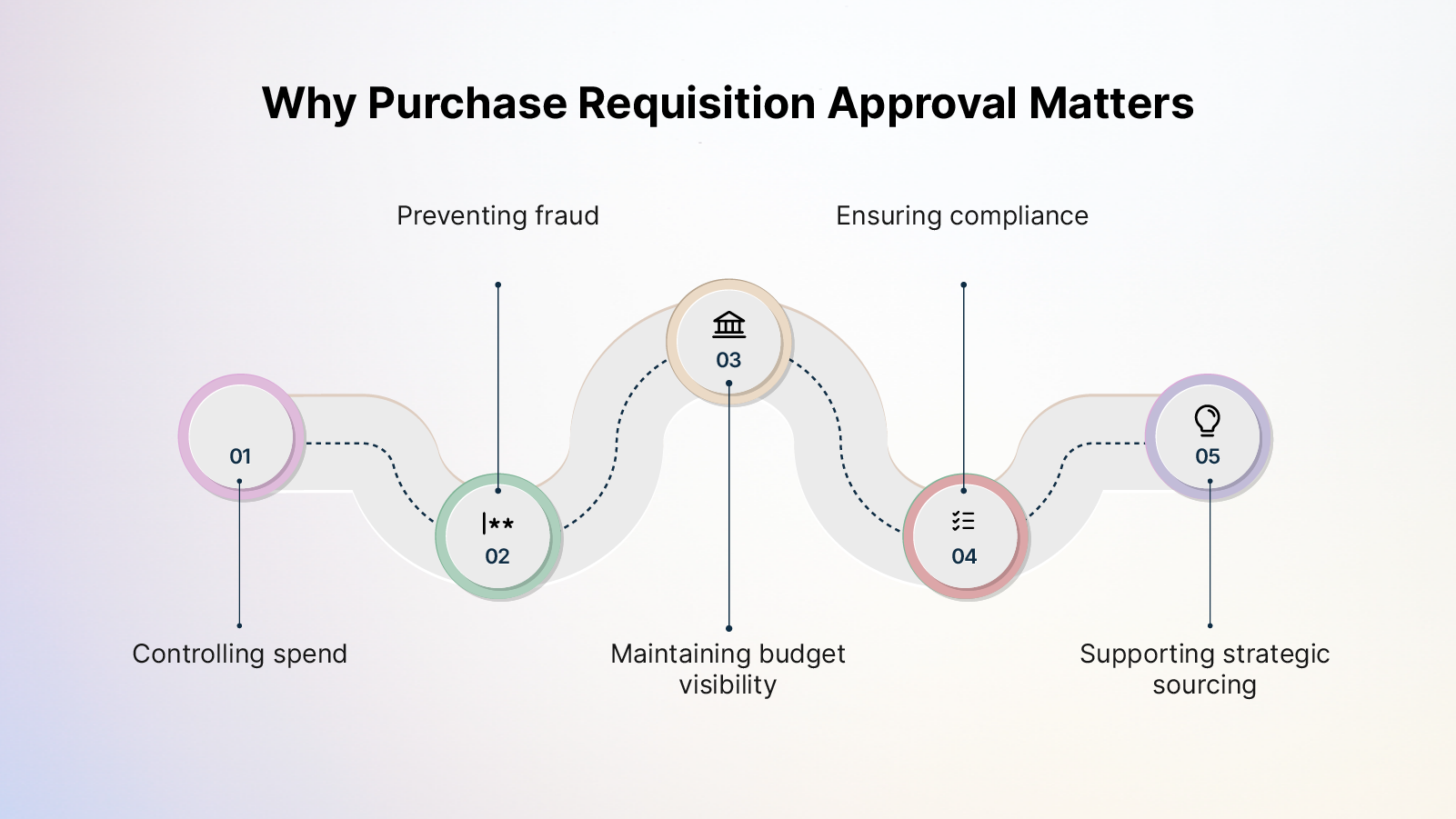
Controlling spend
Approvals ensure that all purchases are necessary and align with company policies and budgets. Without an approval process, employees might make uninformed or unnecessary purchases that drain budgets.
Preventing fraud
A multi-step approval workflow helps catch any fraudulent or unauthorized purchase attempts. Proper approvals mitigate the risk of employees making personal purchases with company funds.
Maintaining budget visibility
As requisitions are approved, it provides real-time visibility into committed spend against budgets. Finance can see what funds are already earmarked and make informed budgeting decisions.
Ensuring compliance
Approval steps confirm that purchases adhere to any regulatory or internal compliance requirements. This is especially important for industries with strict purchasing guidelines, such as government contracting or healthcare.
Supporting strategic sourcing
The approval process allows procurement to guide purchases to preferred vendors or contracts. By reviewing requisitions before they become POs, procurement can leverage spend consolidation opportunities and secure the best value.
Types Of Purchase Request Approvals
Purchase requisition approvals can be configured in various ways depending on an organization’s unique needs and structure:
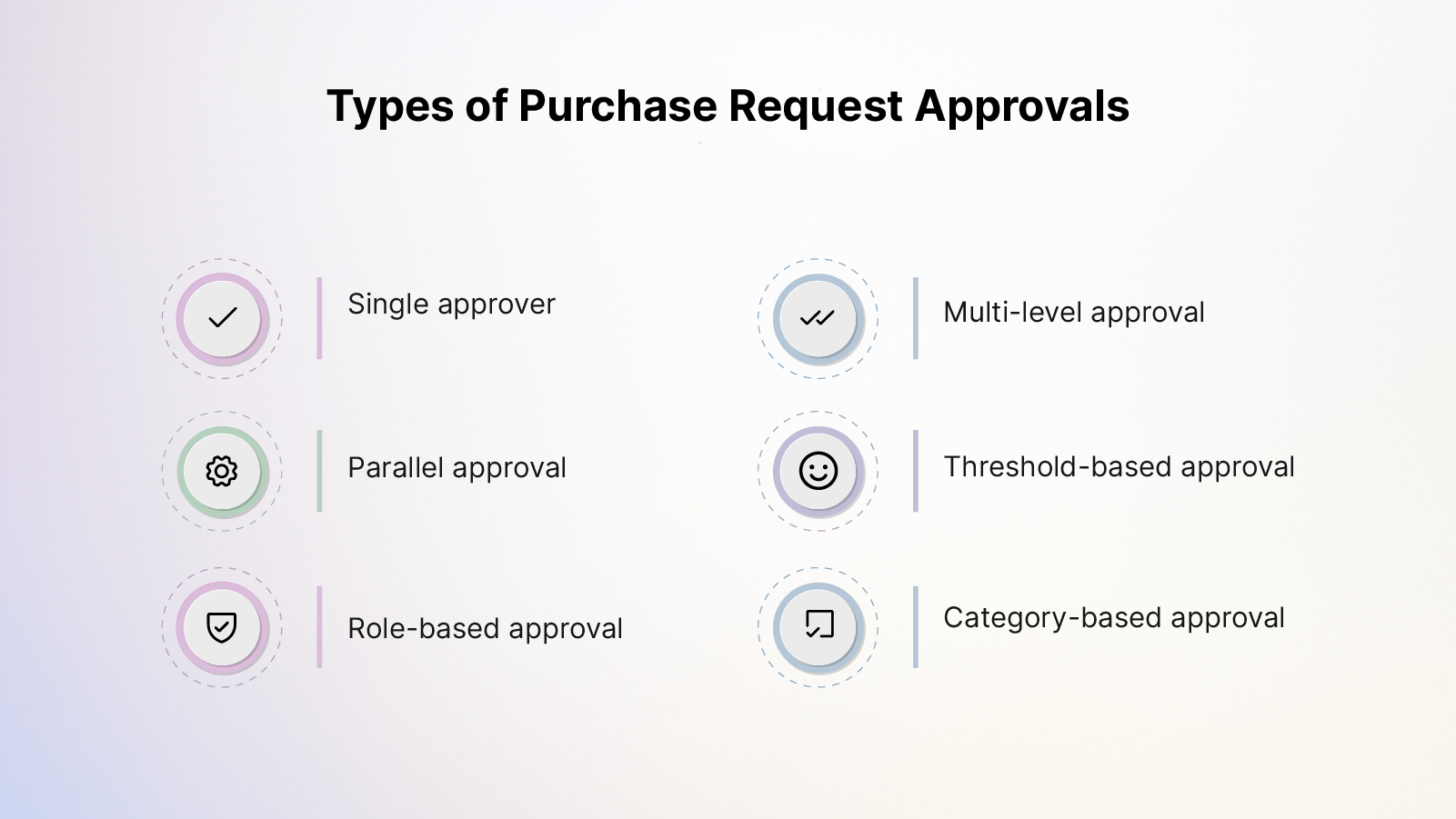
Single approver
For small purchases or in lean organizations, the requisition may only need approval from one person, typically the direct manager. This keeps the process simple but may not provide adequate checks for more significant spend.
Multi-level approval
Most organizations use a multi-level approval workflow, where the requisition must pass through multiple approvers in a sequential flow. For example, it may go from the manager to the department head to finance. This provides more thorough oversight but can slow down the process.
Parallel approval
In some cases, a requisition may need approval from multiple stakeholders simultaneously, such as both the department head and budget owner. Parallel approvals can speed up the process by avoiding sequential waits.
Threshold-based approval
Approval workflows can be configured to change based on certain parameters, most commonly the monetary value. For example, requisitions under $500 may only need manager approval, while those over $10,000 require additional executive sign-off.
Role-based approval
Approvals can also be routed based on the role or level of the requester. Junior employees may have more stringent approval requirements than managers or executives
Category-based approval
Certain categories of purchases may warrant special approvals. For example, all IT purchases may require CIO approval, while all marketing buys need CMO sign-off.
The key is to design an approval workflow that provides sufficient control and visibility without overly burdening the process. The right balance will depend on factors like company size, industry, risk tolerance, and purchasing volume.
Purchase Requisition Approval Flow Example
To illustrate how purchase requisition approvals work in practice, let’s walk through an example.
Suppose Acme Inc. is a mid-sized manufacturing company. They have the following purchase requisition approval process:
- Employee submits purchase requisition in the procurement system
- Manager approval - the direct manager reviews the request for necessity and budget alignment
- Director approval - requisitions over $1,000 are routed to the department director for approval
- VP approval - requisitions over $10,000 require additional approval from a VP
- Legal review - the legal department reviews any requisitions with contract terms or regulatory requirements
- Finance approval - the finance team does a final review for budget availability and proper accounting
- Procurement processing - once fully approved, procurement converts the requisition into a purchase order
Now let’s say John, an engineer at Acme, needs to purchase a new piece of testing equipment for $15,000. Here’s how the process would unfold:
- John creates a new purchase requisition in the procurement system, filling in the item details, price, business need, and suggested vendor.
- The requisition routes to John’s manager, Sara. Sara reviews the request and approves it, believing it’s necessary for John’s work.
- Since the amount is over $1,000, the requisition then goes to the Engineering Director, Mark. Mark also approves, as it aligns with the department’s equipment budget.
- Because the requisition is over $10,000, it’s escalated to the VP of Operations, Lisa. Lisa has some questions about the choice of vendor. She sends the requisition back to John for clarification. John provides additional detail and resubmits.
- Lisa now approves the requisition, and it moves on to legal review. The legal team approves the standard contract terms.
- The requisition finally goes to finance for budget and accounting review. The finance controller approves, and the requisition is now fully approved.
- The approved requisition flows to the procurement team, who flips it into an official PO and sends it to the vendor to initiate the order.
Throughout this process, John could log into the procurement system and see exactly where his requisition was in the approval flow. And all stakeholders had the necessary level of visibility and control over the significant purchase.
Challenges In The Purchase Requisition Approval Process
While purchase requisition approvals are essential, the process is not without its challenges, such as:
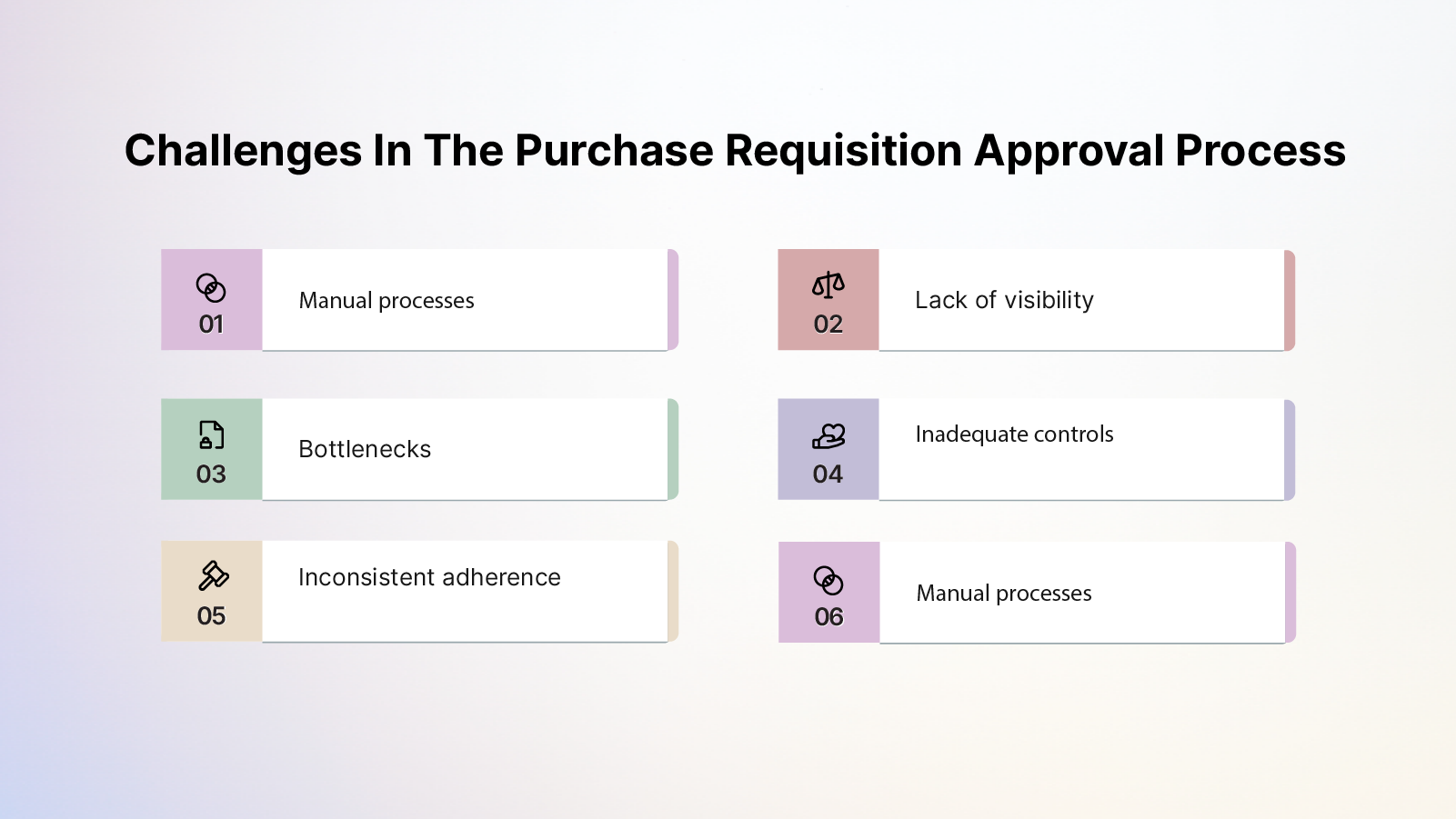
Manual processes
Many organizations still rely on paper-based or email-driven requisition approvals. These manual methods are time-consuming, hard to track, and prone to errors and delays. Requesters have to follow up with approvers to keep things moving or get status updates.
Lack of visibility
Without a centralized procurement system, requesters often have no insight into where their requisition is in the approval flow. This lack of transparency leads to frustration and wasted time spent chasing down approvals
Bottlenecks
Approvals can get held up by a single person in the chain, especially if they are out of office or simply behind on their workload. These approval bottlenecks delay purchases and slow down business velocity.
Inadequate controls
On the flip side, organizations can go overboard with approvals, requiring sign-off for even the smallest purchases. Or they may fail to set proper thresholds, allowing larger buys to sail through without scrutiny. Striking the right balance of control is tricky
Inconsistent adherence
Even with defined approval policies, employees may try to sidestep the process. They might split purchases into smaller amounts to avoid thresholds, or pressure approvers to rubber-stamp requisitions. Without active enforcement, maverick spend can sneak through.
Disconnect from contracts
Purchase approvals often happen in isolation, without insight into existing contracts or pricing agreements. This disconnect can lead to off-contract spending and missed savings opportunities
How To Streamline Your Purchase Requisition Approval Process
Here are some strategies to streamline your purchase requisition approval process for greater efficiency and effectiveness:
Implement procure-to-pay software
Adopt a procurement system that digitizes and automates the entire purchasing lifecycle, from requisition to payment. Look for features like configurable approval workflows, mobile approvals, and automatic alerts and reminders. Procurement automation can dramatically reduce approval times while improving policy adherence.
Integrate budgets
Connect your procurement system with your ERP or budgeting tool to enable real-time budget lookups. With live budget visibility, approvers can make informed decisions and prevent accidental overspend. Budget integration also reduces the need for additional finance review steps.
Set clear policies
Document and communicate clear policies around requisition approvals. Define approval thresholds, delegate authority, and specify any category-specific rules. Make sure the policies are easily accessible and understood by all employees. Consider implementing in-system controls that enforce the rules and guide users to comply.
Design efficient workflows
Map out your ideal approval flow and implement it in your procurement system. Minimize the number of approvers involved while still maintaining adequate control. Use parallel approvals where possible to avoid bottlenecks. Leverage conditional logic to automatically route approvals based on pre-set criteria.
Analyze and adjust
Regularly review metrics like approval cycle times, on-time approvals, and first-pass yield. Identify bottlenecks and process breakdowns. Gather feedback from requesters and approvers on pain points. Use these insights to continually optimize your approval workflows and policies.
Looking to automate this entire approval flow end-to-end? Explore the best Purchase Requisition Software that simplifies approvals and reduces manual steps.
Optimize your purchase requisitions approval process with Spendflo
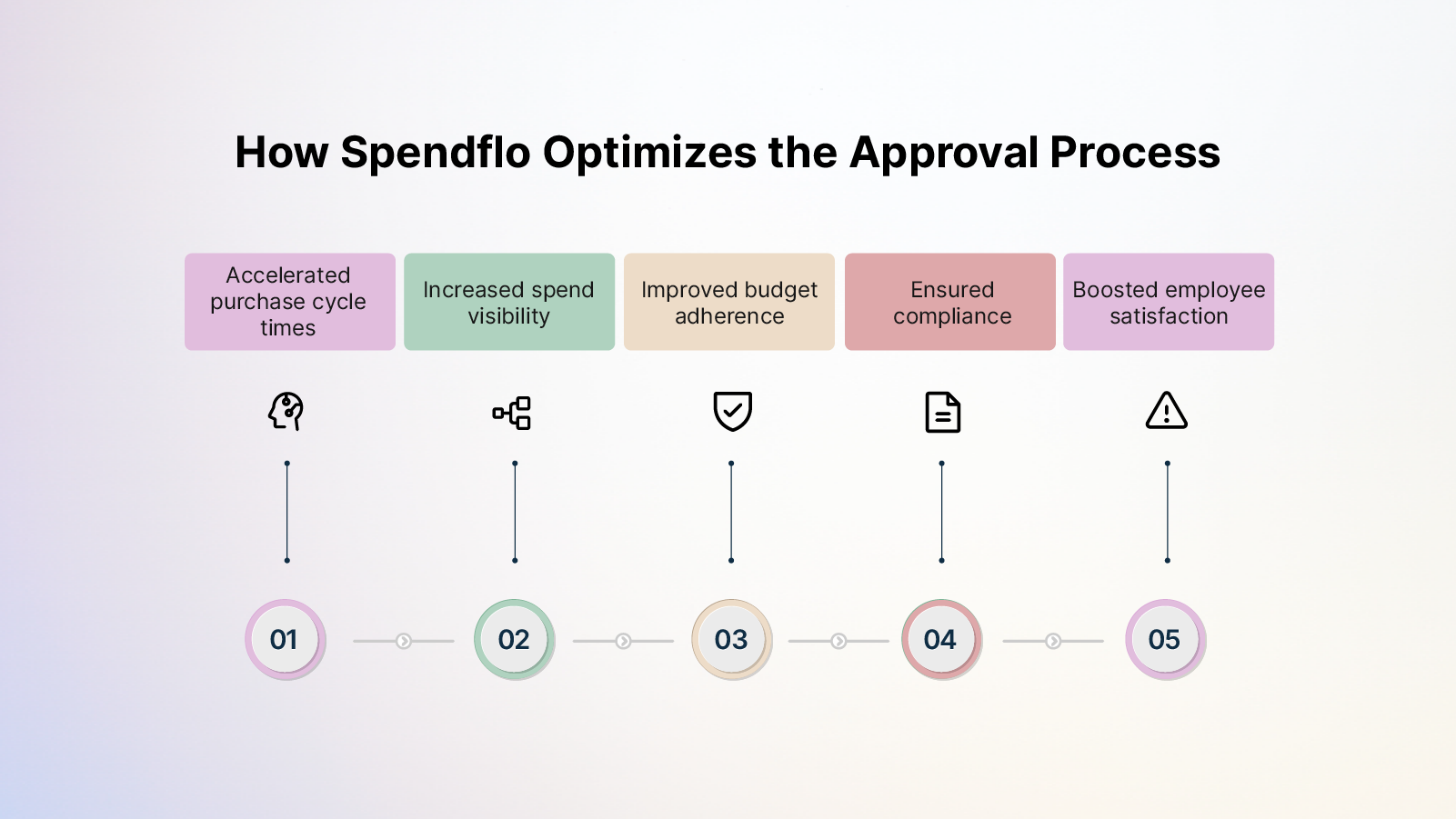
An optimized purchase requisition approval process is crucial for effective spend management, ensuring all purchases are thoroughly vetted and authorized. However, traditional manual approvals are often slow, opaque, and inconsistent.
With Spendflo's procure-to-pay software, you can streamline your approval process and achieve:
- Accelerated purchase cycle times
- Increased spend visibility
- Improved budget adherence
- Ensured compliance
- Boosted employee satisfaction
Frequently Asked Questions on Purchase requisitions approval workflow
What is the difference between a purchase requisition and purchase order?
A purchase requisition is an internal request to purchase goods or services. Once approved, the requisition becomes a purchase order, which is an official document sent to a vendor to place an order.
Who is involved in the purchase requisition approval process?
The exact approvers will vary by organization, but often include the requesting employee’s manager, department head, budget owner, and finance team. Other potential approvers include legal, IT, and executive leaders.
What happens if a purchase requisition is rejected?
If a requisition is rejected, the requester is usually notified with a reason for the rejection. The employee can then make changes to address the issues and resubmit the requisition for approval.
Can I set up different approval workflows for different types of purchases?
Yes, most modern procurement systems allow you to configure dynamic approval workflows based on criteria like spend amount, category, department, or vendor. This flexibility lets you tailor the approval process to your unique needs.
How can I speed up purchase requisition approvals?
There are several ways to accelerate approvals, such as automating the process with procurement software, setting clear policies and thresholds, simplifying approval flows, and integrating with budgeting systems. Analyzing and optimizing your approval cycle times can also help identify and remove bottlenecks.
What are the types of Purchase requisition approval process?
There are several types of purchase requisition approval processes, including single approver, multi-level approval, parallel approval, threshold-based approval, role-based approval, and category-based approval. The choice of approval process depends on factors such as company size, industry, risk tolerance, and purchasing volume, with the goal of balancing control and efficiency.














.png)










.avif)





